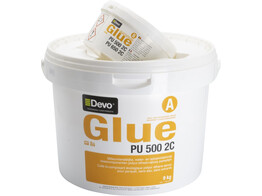01 June 2023
Guidelines for installing parquet on underfloor heating
Discover essential guidelines for installing parquet on underfloor heating. Follow these tips for a successful installation.
- In order to obtain sufficient heating capacity, the thermal resistance R of the total parquet floor construction must not exceed 0.18 m² K/W.
Some examples (according to DIN4108) of the thermal resistance of some commonly used parquet types:- Mosaic parquet oak 8mm R = 0.04 m² K/W
- Strip parquet oak 22mm R = 0.11 m² K/W
- Compound parquet 10-15mm R = 0.07 to 0.12 m² K/W
With floating installation, the thermal resistance of the subfloor must also be taken into account.
(floating installation is not recommended on underfloor heating)
- The heating pipes must be covered with a cement screed of at least 35 mm thickness.
- Maximum moisture percentage of the cement screed 2%, anhydrite 0.5%. Never use underfloor heating to force the screed to dry faster. This may cause cracks!
- The surface temperature of the finished floor must never exceed 26 to 27°C.
- The water temperature in the circuit must never exceed 55°C.
- Wood moisture content: Always measure the wood moisture content before starting the installation.
- Mosaic parquet: 9% ±2
- Flooring softwood: 9% ±2
- Flooring hardwood: 9% +3;-2
- Composite parquet: 7% ±2
Parquet whose wood moisture content is close to the maximum allowable moisture content (or higher) is too moist for installation on underfloor heating. Due to rapid drying, when the underfloor heating is started up, strong shrinkage, shimming and possible loosening of the glue joint may occur! However, seam formation cannot be avoided. However, this can be reduced somewhat by choosing more stable types of wood and preferably gluing with Devo Glue PU 500 2C.
- Preheating before installation according to the following method: after curing the screed (screed floor), the heater must run for at least 14 days at a temperature half as high as the later operating temperature. Halfway through this period, the heater should be run at later operating temperature maximum capacity for at least 2 days. 1 to 2 days before installing the parquet, the heater should be turned off or, depending on the outside temperature, lowered so that the surface temperature of the screed does not exceed 18°C. 24 hours after finishing the installation, the temperature can be increased by up to 1 to 2°C every day.
- For the gluing we recommend Devo Glue PU 500 2C. This adhesive is more resistant to temperature fluctuations and high tensile stresses. If in doubt about the mechanical characteristics of the cement screed, Devo Primer PA400 or Devo Primer Express PU can be applied as a primer. This treatment ensures binding of the dust, and better adhesion and compactness.
- Please ensure that during the heating season, the temperature of the heating and the floor remain as constant as possible, otherwise the wood may shrink, swell or crack.
- Please also read the guidelines for installation of parquet on cement screeds.
Note
- As in any home where there is a parquet floor, keeping the relative humidity (RLV) stable between 40 and 70% is very important to prevent damage.
- For the proper use of specific products described here, please refer to the corresponding technical data sheet.
- The information described here is based on our many years of experience and research, and is intended to provide technical support to our esteemed customers. Since the method of application cannot be controlled or influenced by us, no liability can be accepted on the basis of this information.
- Our product warranty only covers the quality of our products, their correct application is the responsibility of the user. Please always seek advice from our technical advisors for specific applications.




